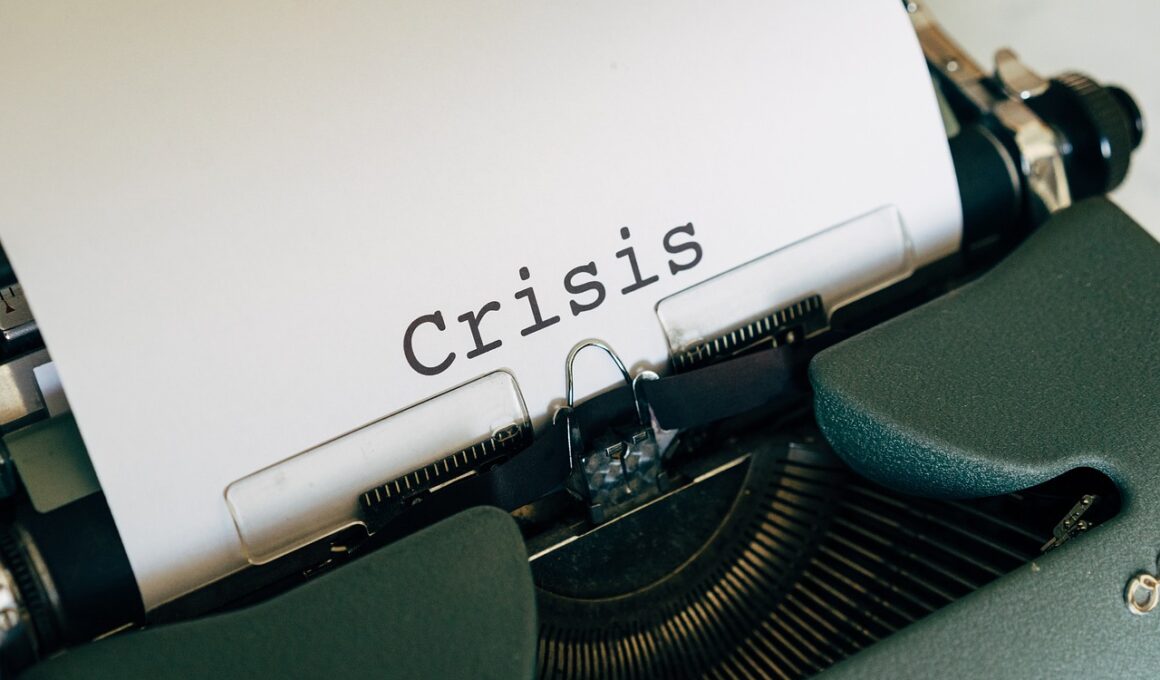Engaging Your Community in Financial Crisis Recovery Efforts
Engaging your community is key when it comes to recovering from a financial crisis. When individuals and organizations work together, they can pool resources, knowledge, and support systems. This collaboration encourages enhanced resilience among community members, fostering a united front against adversity. The community forms the backbone of recovery, and by creating networks, individuals can share insights and strategies that can facilitate the recovery process. It involves bringing people together to identify available resources such as financial aid, counseling services, and training programs. Hosting workshops and forums can serve as platforms to educate community members about financial literacy. These events empower individuals, equipping them with enhanced financial management skills. By providing information on budgeting, saving, and investing, community members can make informed decisions that bolster their economic stability. Engaging local businesses can also contribute significantly to recovery efforts. They can offer internships, job openings, or financial incentives that benefit the overall economic environment. Partnerships between local organizations and government resources ensure a comprehensive recovery strategy for everyone involved.
Strategies for Community Engagement
Implementing effective strategies for community engagement is crucial during financial crises. Community leaders can prioritize outreach efforts, ensuring that residents are informed about available resources. Hosting informational sessions, both in-person and online, helps disseminate knowledge regarding assistance programs. Leveraging social media platforms is an effective way to reach diverse demographics, providing timely information. Additionally, creating neighborhood committees can allow residents to voice their concerns. These committees can then collaborate with local authorities to address financial challenges specific to their district. Encourage participation in local decision-making processes by inviting residents to town hall meetings and forums. This creates transparency and instills a sense of ownership over recovery efforts. Providing avenues for feedback ensures that community needs are acknowledged and addressed. Connecting residents with financial advisors or counselors can provide necessary guidance tailored to individual situations. Forming partnerships with nonprofit organizations can enhance resource availability, offering workshops and training that equip members with vital financial knowledge. Facilitate networking opportunities to strengthen local support systems, as collaboration can often unveil innovative solutions to shared struggles during recovery initiatives.
Communication plays an essential role in community engagement. Clear, consistent communication ensures residents remain informed about support channels and resources available to them. Organizations can employ newsletters, local newspapers, and digital platforms to share updates on relief efforts. It is vital to use accessible language free from jargon; this ensures everyone can comprehend the information presented. Moreover, employing multiple communication channels can capture a broader audience. Videos, infographics, and testimonials can help convey messages more effectively and resonate with people. Observing community sentiment also aids in understanding how best to engage members during a crisis. Surveys can gauge how the community is coping and what additional resources are needed. Promptly addressing resident inquiries reinforces trust and demonstrates commitment to supporting community wellness. Tailoring communication methods to fit the diverse needs of community members can yield positive engagement outcomes. Utilizing local leaders or trusted figures can facilitate outreach as they can encourage participation and lend credibility to initiatives. Lastly, investing in platforms that foster two-way communication fosters dialogue and empowers residents to share their experiences and challenges in navigating financial difficulties.
Resource Mobilization and Sharing
Resource mobilization is pivotal for community recovery efforts during financial crises. Local governments, NGOs, and community organizations must collaboratively identify and allocate resources swiftly. This can begin with assessing available materials, such as food banks, emergency funds, or mental health services. The establishment of a centralized database, detailing what resources are accessible, can ensure that residents have immediate knowledge of the assistance available. Creating an online platform that allows community members to share information about financial resources can spur innovation and cooperation. Initiatives to gather donations, such as clothing drives or fundraising events, encourage residents to contribute to recovery efforts. Highlighting case studies of local families benefiting from aid can inspire others to participate actively. Residents feeling connected to such stories are often more likely to engage in resource-sharing initiatives. Hosting community fairs can also serve as opportunities for resource distribution, bringing together those in need with service providers. Collaboration among community leaders to design resource-sharing strategies can amplify impact, as collective efforts often yield more substantial results than isolated attempts. This step is crucial in creating a united approach to overcoming financial hardships.
Engaging local businesses also forms a significant aspect of mobilizing resources during recovery from financial crises. Collaborative efforts between community organizations and businesses can lead to initiatives that provide job opportunities and training for residents. Businesses can offer internships to empower individuals and develop essential work skills. Moreover, local enterprises can contribute financially through donations or sponsorships for community initiatives. Encouraging businesses to mentor start-ups can nurture entrepreneurship, allowing residents to create their pathways to financial independence. Hosting joint events with businesses serving as sponsors creates unique opportunities for community interaction. These events can feature workshops, bringing expert insights about financial tools and strategies to participants. Providing small grants or incentives for local businesses that support recovery initiatives can also spur further community investment. As businesses thrive, so does the economic environment, resulting in enhanced community resilience. By fostering relationships between residents and entrepreneurs, communal networks expand. Ultimately, these connections bolster recovery efforts and reshape the local economy to be more inclusive, supportive, and adaptable to future challenges. The engagement of every sector strengthens the community’s overall capacity to respond to financial crises.
Measuring Impact and Progress
Measuring impact and progress in financial crisis recovery efforts is essential for understanding community engagement effectiveness. Institutions involved in recovery initiatives need to establish key performance indicators (KPIs) to track engagement levels. These KPIs might include the number of community members accessing resources, participation rates in workshops, and the overall satisfaction regarding the support received. Developing feedback mechanisms allows for continuous evaluation, helping organizations adapt strategies to meet community needs better. Regularly sharing progress reports with the community fosters transparency and encourages sustained participation. Identifying success stories within the community can also motivate residents to remain engaged in recovery efforts. Documenting these narratives highlights the importance of collective action in overcoming financial difficulties. Community surveys can help gauge sentiment and identify areas that need improvement or enhancement. Additionally, digital tools can facilitate data collection, allowing for real-time adjustments to strategies deployed. Engaging researchers or academics can provide valuable insights through data analysis, helping communities enhance their response mechanisms. Ultimately, measuring impact allows community leaders to refine approaches, ensuring ongoing resilience in the face of financial challenges.
As community members become engaged, it’s essential to visualize their contributions and milestones achieved during recovery. Hosting community events to celebrate progress can instill a sense of belonging and accomplishment among participants. Recognizing individuals and organizations that have made significant contributions fosters a culture of gratitude and motivation. Awards ceremonies or appreciation days can be organized, serving as a platform for people to share their experiences and hear inspiring stories from others who have successfully navigated challenges. Leveraging art, storytelling, and public showcases can significantly enhance community bonding and motivate others to participate actively. By aligning monthly themes or objectives, communities can keep the momentum alive and the focus clear. Sharing future goals and successes creates a roadmap that highlights ongoing engagements, informing everyone of the next steps. Promoting collective achievements fosters pride and unity as residents recognize their role within the larger recovery effort. Use social media to amplify these stories and milestones, ensuring even those who could not attend still feel involved. Celebrating success not only boosts morale but also reinforces the vision of a resilient and empowered community.
Conclusion & The Path Forward
In conclusion, engaging communities in financial crisis recovery requires a multifaceted approach. It consists of encouraging communication, resource mobilization, and fostering local partnerships. Strengthening community ties enables collective resilience in facing challenges. Leaders must stay proactive about listening to community needs and adapt accordingly. This evolving relationship between organizations and residents will be crucial for addressing issues prevalent during financial instability. Continuous investment in educational efforts helps empower residents, providing them with skills to navigate financial decisions wisely. Supporting local businesses and innovating resource-sharing strategies will pave the way for economic recovery. Establishing metrics for success will measure not only individual well-being but also community resilience. As communities celebrate their small victories, they should envision long-term strategies that reinforce economic stability. By cultivating an environment of collaboration and trust, communities can harness their collective strength. A strong network will ultimately mitigate the impact of future financial crises, as engaged residents become catalysts for sustainable change. With effort and commitment, community members can build brighter futures, emerging better equipped to face whatever financial challenges may lie ahead.


